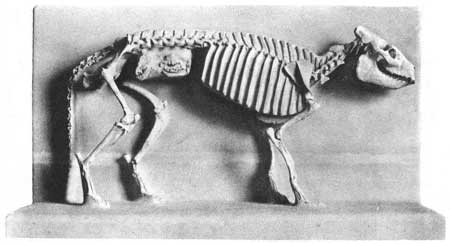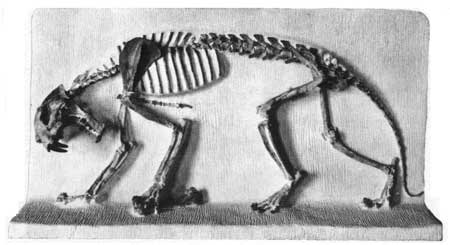|
BADLANDS National Park |
 |
Local Life of the Oligocene Epoch
Ancestors of many modern animals lived during Oligocene time. Fossil remains from many have been found in Badlands National Monument; fossils of those not found here have been discovered in Oligocene rocks of neighboring localities. Paleontologists (scientists who study the life of past geologic periods) have identified remains of early forms of the horse, camel, rhinoceros, tiger, opossum, pig, and dog. We know that primitive rats, mice, squirrels, marmots, beavers, rabbits, and turtles also existed at this stage in the earth's development; but very few are similar to species living today. We also know there were lizards, owls, eagles, gulls, and pelicans; but there are only a few fossil records of them. The bones of these small reptiles and birds were too fragile to survive in quantity. The first horse, about the size of a domestic cat, appeared at the dawn of the Tertiary period (some 20 million years before the Oligocene epoch). By the beginning of the Oligocene, it had evolved into an animal about the size of a sheep. Other strange creatures such as the oversized titanothere and brontothere no longer exist.
The swampy areas were death traps that claimed the lives of scores of animals. We assume that the larger ones were mired in the muds and sands and could not extricate themselves, and others died of disease, were killed by predators, or succumbed from other natural causes. In any event, the skeletons of many species are entombed in the badlands rocks.
 Fossils of animals are frequently found in the rocks of the badlands VERNE ORDAHL PHOTOGRAPH |
After the bodies were covered by mud and the fleshy parts decomposed, petrifaction began. In brief, this process consists of the infiltration of buried bones by mineral-carrying waters and deposition of material, usually silica (which has great hardness), in the pores and other open spaces of the bones. Thus, instead of a normal skeleton, a hard and resistant structure is formed. These stoney skeletons (fossils) are normally much more durable than the enclosing rocks and, as the softer covering is worn away, the fossils tumble to the base of cliffs or are left exposed in the rocks.
We have already noted that the first published record of a Badlands fossil appeared in 1846. After the first few accounts called attention to this region, a great deal of collecting was done and fossils were sent to most major museums in the country. Collection of fossils on public land is now limited to approved scientific institutions operating under special permits. Excellent collections of Oligocene fossils are on display at the museum of the South Dakota School of Mines and Technology in Rapid City and the University of Nebraska Museum in Lincoln. You are welcome to visit these museums, where you may profitably spend several hours studying the fascinating story of the life of this bygone epoch.
 An articulated skeleton of an oreodon, a primitive cud-chewing, sheep-sized animal, here with unborn twins. This is displayed in the museum of the South Dakota School of Mines and Technology in Rapid City SOUTH DAKOTA SCHOOL OF MINES AND TECHNOLOGY PHOTOGRAPH |
 A saber-toothed cat skeleton from an exhibit in the museum of the South Dakota School of Mines and Technology. This animal was about the size of a large lynx SOUTH DAKOTA SCHOOL OF MINES AND TECHNOLOGY PHOTOGRAPH |

|

|
|
|
|
Last Modified: Sat, Nov 4 2006 10:00:00 pm PST |


